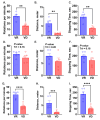Pre- and Postnatal Vitamin A Deficiency Impairs Motor Skills without a Consistent Effect on Trace Mineral Status in Young Mice
- PMID: 39409135
- PMCID: PMC11477164
- DOI: 10.3390/ijms251910806
Pre- and Postnatal Vitamin A Deficiency Impairs Motor Skills without a Consistent Effect on Trace Mineral Status in Young Mice
Abstract
Pregnant women and children are vulnerable to vitamin A deficiency (VAD), which is often compounded by concurrent deficiencies in other micronutrients, particularly iron and zinc, in developing countries. The study investigated the effects of early-life VAD on motor and cognitive development and trace mineral status in a mouse model. C57BL/6J dams were fed either a vitamin A-adequate (VR) or -deficient (VD) diet across two consecutive gestations and lactations. Offspring from both gestations (G1 and G2) continued the same diets until 6 or 9 weeks of age. Behavioral assays were conducted to evaluate motor coordination, grip strength, spatial cognition, and anxiety. Hepatic trace minerals were analyzed. A VD diet depleted hepatic retinoids and reduced plasma retinol across all ages and gestations. Retracted rear legs and abnormal gait were the most common clinical manifestations observed in VD offspring from both gestations at 9 weeks. Poor performance on the Rotarod test further confirmed their motor dysfunction. VAD didn't affect hemoglobin levels and had no consistent effect on hepatic trace mineral concentrations. These findings highlight the critical role of vitamin A in motor development. There was no clear evidence that VAD alters the risk of iron deficiency anemia or trace minerals.
Keywords: concurrent micronutrient deficiencies; growth retardation; maternal vitamin A deficiency; motor dysfunction; mouse model.
Conflict of interest statement
The authors declare no conflicts of interest.
Figures




References
-
- Song P., Adeloye D., Li S., Zhao D., Ye X., Pan Q., Qiu Y., Zhang R., Rudan I., Group G.H.E.R. The prevalence of vitamin A deficiency and its public health significance in children in low-and middle-income countries: A systematic review and modelling analysis. J. Glob. Health. 2023;13:04084. doi: 10.7189/jogh.13.04084. - DOI - PMC - PubMed
-
- Haddad L.J., Ross J.S. 5th report on the world nutrition situation: Nutrition for improved development outcomes; Proceedings of the United Nations System Standing Committee on Nutrition (SCN); Geneva, Switzerland. 13–17 March 2004;
MeSH terms
Substances
Grants and funding
LinkOut - more resources
Full Text Sources

